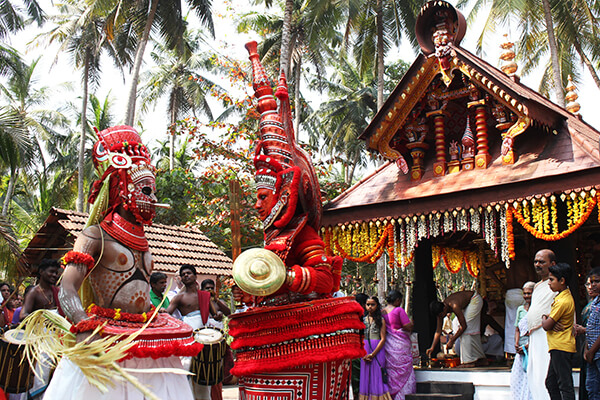Getting to know Kannur
Part 1: An early morning start - meeting Praveen Shenoy
Posted by ClaireI was introduced to Praveen through my hotel in Kannur. We spoke on the phone and discussed possible local cultural visits. The following morning he came to pick me up at 4.45am to attend a theyyam in a nearby village. We drove through dark sleep-filled streets leading out of town which became smaller and narrower. Further on, we approached a piece of road lined and lit up with vertical fluorescent tube lights, announcing the location of the temple and its festival.
It was the season for temple festivals in Kerala, and it was the theyyam season in north Kerala. All over this region of northern Malabar between October and May, there are daily and often twice-daily programmes in shrines and temples devoted to the local residing deities, spirit animals and folk heroes. Some can last for up to three days.
Praveen had thoughtfully brought a flask of masala tea with him, and we had a quick cup and a couple of biscuits before heading across a large open grassy expanse, set up for the occasion with stalls selling children’s toys, salted pickles, snacks, and sweets. There were a few miniature childrens’ fairground rides too. All these were quiet now, the proprietors either sleeping or waiting to watch the theyyam. These festivals are attended by the whole village and surrounding areas and are social as well as spiritual.

The sacred enclosure was marked out on two sides by low platform walls with three or four steps up to them. These were filled with people of all ages, many lying down and sleeping on straw mats, others sitting and chatting. They had already arrived the previous day or evening to witness the initial preparations and rituals. The families of the performers and musicians occupied part of this area to one side of the temple enclosure, camped out and in residence for the duration of the festival. It was still dark, and large lights were rigged up in the surrounding trees.
One of the marvellous things about theyyam is that the make up and dressing of the persons performing the rituals is done in full view of everyone present. There is no back stage, and these elaborate preparations are carried out slowly, carefully and lovingly by members of the family and caste. It’s an integral part of the proceedings. Time becomes inconsequential, merely forming a backdrop and witness to these extraordinary spectacles that are played out in their own time. The natural settings are another important feature of this tradition which has ancient roots and is a form of offering to the deities in return for protection and security.
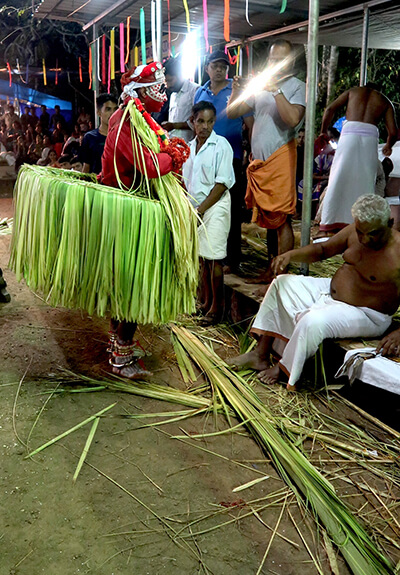
The tradition is passed down through families, and the right to perform inherited. The rituals, characters, dances and songs of each deity have to be learned, along with the making of the costumes and the paint which is applied to faces and upper bodies. Stamina is an absolute must for these performers, who often spend nights into days in their unwieldy costumes, supporting towering head dresses, dancing, spinning, on their feet for hours at a time. Some rituals involve having lit torches tied to waists. Once the performer has channelled the deity, he will settle himself and give advice and blessings to devotees, often in the heat of the day. A month of fasting before the season begins helps to prepare these men spiritually and physically.
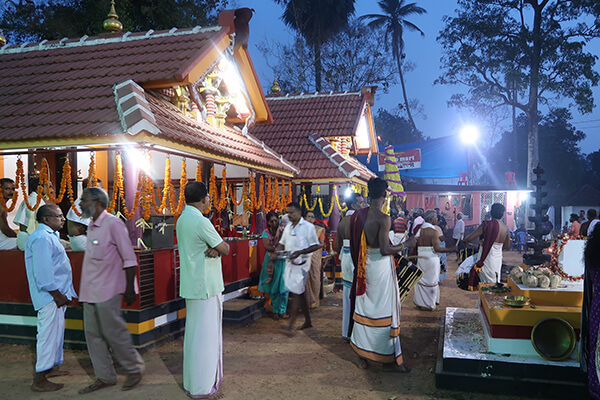
The temple compound was thronging with temple officiators, the performers and their entourage, musicians and spectators. As the anticipation in the audience gathered momentum, young boys dressed in traditional miniature-sized dhotis were excitedly fetching things and helping to tie the different elements of the costumes together. The elders, retired from performing, were also on hand to advise and give their blessings.
The first performer was now ready and presented before the main shrine. He recited a prayer to manifest the power of the deity. The circumnavigation of the temple began slowly, the drummers setting the pace and rhythm. The sacred dance which followed was mesmerising as the performer pranced and reeled between the shrines, his ankles tied with rows of brass bells. The soaring and whooping of drums and oboes, the incantations, the cries of perhaps encouragement or appeasement all became increasingly frenzied and feverish. Later the head dress was attached, so tall that it had to be supported by others. Fire torches were tied at the waist during the climax of his transformation.
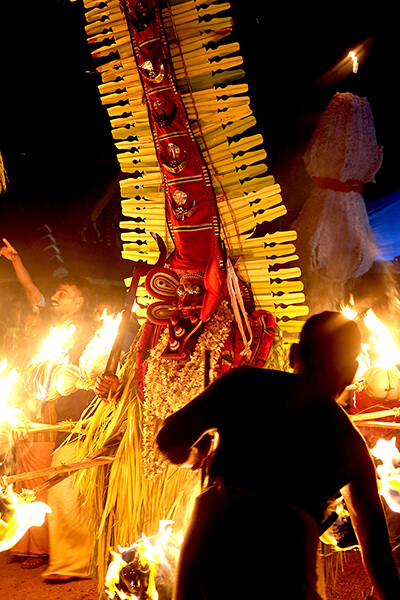
Praveen runs his own business called Real India Tours and Holidays, organizing tailor made visits and tours in northern Kerala, covering Calicut, Kannur, Wayanad and Kasaragod districts. He specialises in trekking, village and jungle walks, and knows a lot about traditional Keralan arts and theyyam. He is also a keen birder I discovered, and has identified 138 birds of 284, the last official count of species recorded in Kannur district. He tells me that Kerala has over 500 official species including migratory and resident birds. He is good company, knowledgeable, thoughtful, tireless, and a great host, all excellent qualities for someone in his line of work.
During a break in the theyyam, Praveen took me on a walk along a nearby river. The wide expanse of water was smooth and heavy, and everything looked inky and blurry. The sun rose soon after, a small coral ball, and I could now make out a number of small canoe shaped boats on the horizon with little hatted silhouettes, fishermen working nets or traps. There was no sound other than birdsong and the occasional crackle of our feet on dry leaves.
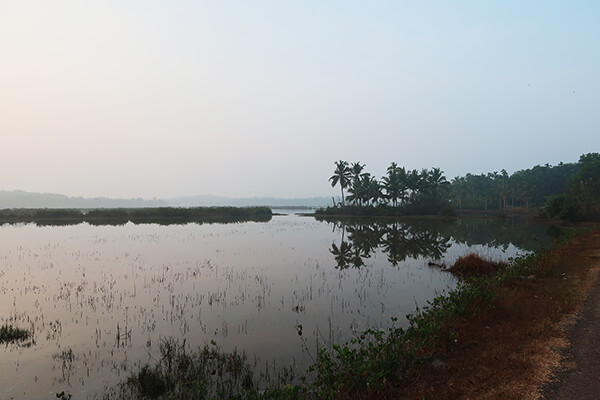
Along the river a narrow worn path led through coconut palms, cashew trees and tall skinny areca palms. Set back behind these were plots of land planted with bananas, lemons, mangoes, drumstick trees and papayas belonging to occasional houses. We met the odd person starting their journey to work, or leading cows or goats to grazing spots further afield. We spotted bulbuls, green bee-eaters, swamp hens, fever tree birds, sun birds, brahmini kites and oriels amongst others. Praveen didn’t miss a thing, with his set of binoculars at the ready.
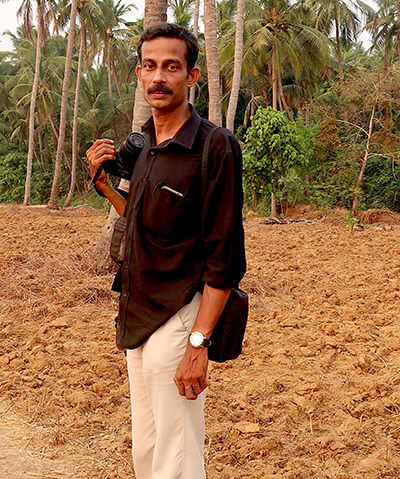
Before being dropped back at my hotel, we visited a small shop Karuvadan Kappi Peediga on one of the main roads out of Kannur. It sold cassava tempered with mustard seeds and curry leaves. Freshly cooked cassava is very tasty and makes a cheap and nutritious snack. Here it is served by the weight. We had 100 grams each on a little steel dish with a spoonful of their house pickle, a delicious green mango and beetroot concoction. This was washed down with another house speciality, chukka kappi, which translates as coffee made with sun-dried ginger. It is served black and is lightly spiced and sweetened with jaggery. They also offer it with a touch of ghee which I had to try as it sounded so odd. It was very good, and a great reviver after the unnaturally early morning start.
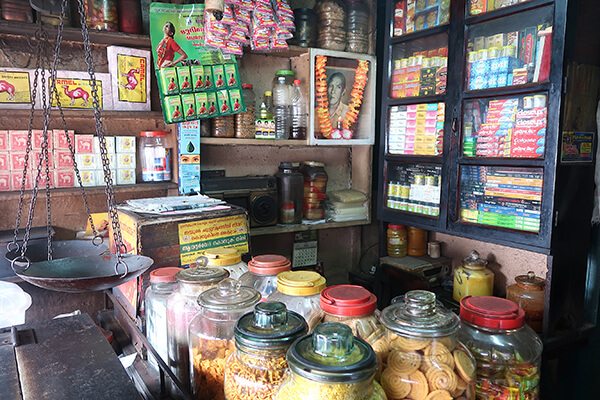
This little jewel of a shop had a coconut shell-fired stove out front, along with a counter and the weighing scales, and a couple of table tops and stools at the back. The owner told us the shop had been in his family for 75 years, offering exactly the same menu. This seemed remarkable, but clearly there has been no need to change anything, it is perfect as it is.
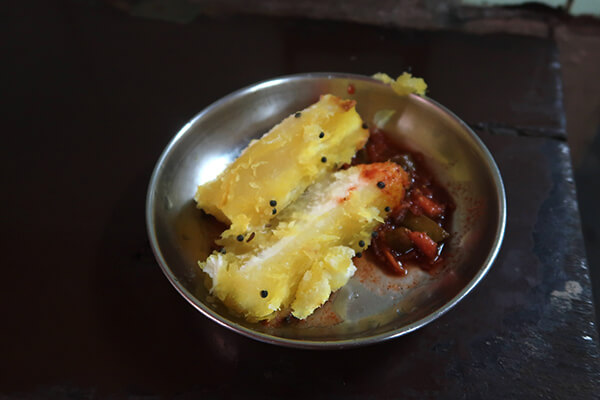
At the time of posting, Praveen and family are in lockdown in Kerala due to the Corona Virus pandemic. He has had to suspend his website and business activities for the time being until the situation changes. He hopes to restart when the situation improves.
